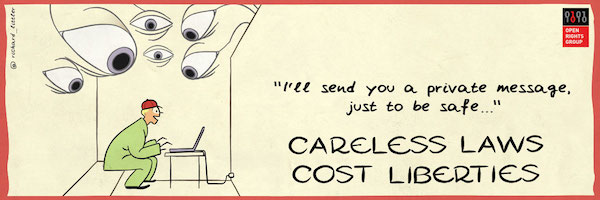The Home Office are having a secret consultation to bork encryption in the name of keeping us safe.
I felt inspired to write them an email. Here it is:
Please don’t weaken encryption and so endanger us in the name of making us safer. Anyone can access backdoors into encrypted software. Not just the “good guys.”
Here is an analogy to show what I mean:
Encryption Housing Developers build a housing estate.
These houses are the most secure design in the world. One of the features of the Encryption House is that they are all laid out exactly the same. The stuff inside each house is different, but the structure of each house is exactly the same. They are completely burglar-proof. Most of the people who live in the housing estate are good, law-abiding citizens. I’m one of those law-abiding citizens. I bought a house in the estate, and I’m very happy with it and feel confident that my stuff will never be stolen.Guy Fawkes also bought one of the houses. But Mr Fawkes is up to no good. the government are watching him closely, because they think he is planning to plant a bomb and blow up the Houses of Parliament. The police want to arrest him before he plants the bomb, but they don’t have enough evidence. He probably has his plot written down in a notebook inside his burglar-proof Encryption House, but the police can’t get to it (Encryption Houses even stop warranted police officers from getting into the house — that is how secure the house design is).
The government passes a law forcing Encryption Housing Developers to dig a secret tunnel into Guy Fawkes’ Encryption House. The tunnel exit into Mr Fawkes’ house is placed there without him knowing. The entrance to the tunnel is on Back Alley Way in Internetborough. The entrance is well-hidden, and only the government know where it is.
Because Encryption Housing Developers had to dig a tunnel into Mr Fawkes’ house, they had to dig a tunnel into every other Encryption House in the housing estate, so that they would all stay exactly the same. Unlike normal houses, if one Encryption House is modified, they all have the same structural modifications. And every Encryption House owner is oblivious to this weakness in the security of their home.But that’s OK. The government only wants to get into Guy Fawkes’ house. It isn’t interested in my stuff in my house, or my other lovely law-abiding neighbours.
The government sneak into Guy Fawkes’ Encryption House, find the documents describing his plot to plant the bomb, and armed with this evidence they arrest him, preventing a terrorist attack.
—
Sarah is part of a criminal gang of very sophisticated burglars called The Hack. She and her gang members like exploring all the side streets and back alleys in Internetborough for secret passages. There are many secret passages in Internetborough.
A little while after Guy Fawkes is imprisoned, Sarah wanders down Back Alley Way. She spends a few hours looking in the wheely bins, in the stormwater drains, through the cracks in boarded up windows, kicking paving stones hoping for a loose one. She bumps a particular brick and door slides open. It’s the secret passage to all the Encryption Houses. Sarah goes and calls the rest of The Hack shows them all the Encryption Houses they can sneak into with impunity. The best thing about the secret tunnel is that the Encryption House owners won’t even know that The Hack have snuck in. What an opportunity. Now The Hack can expand from just burglary, to blackmail, identity theft, fraud, and all other kind of lucrative illegal business opportunities.


